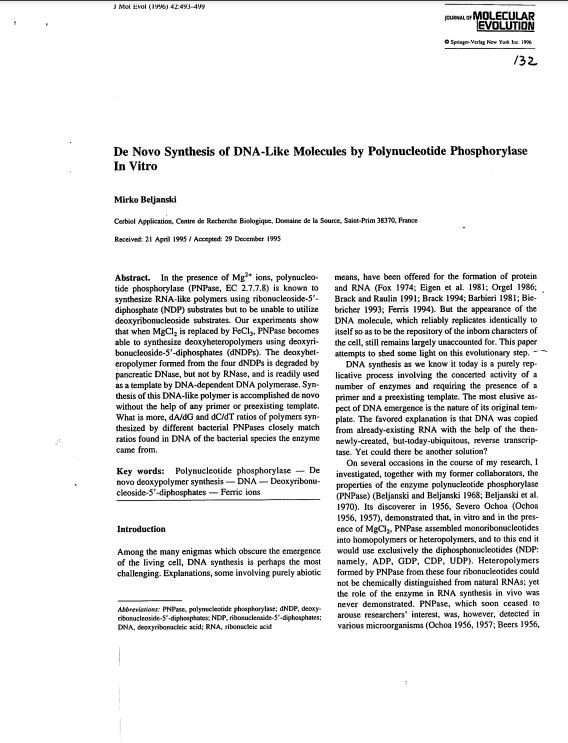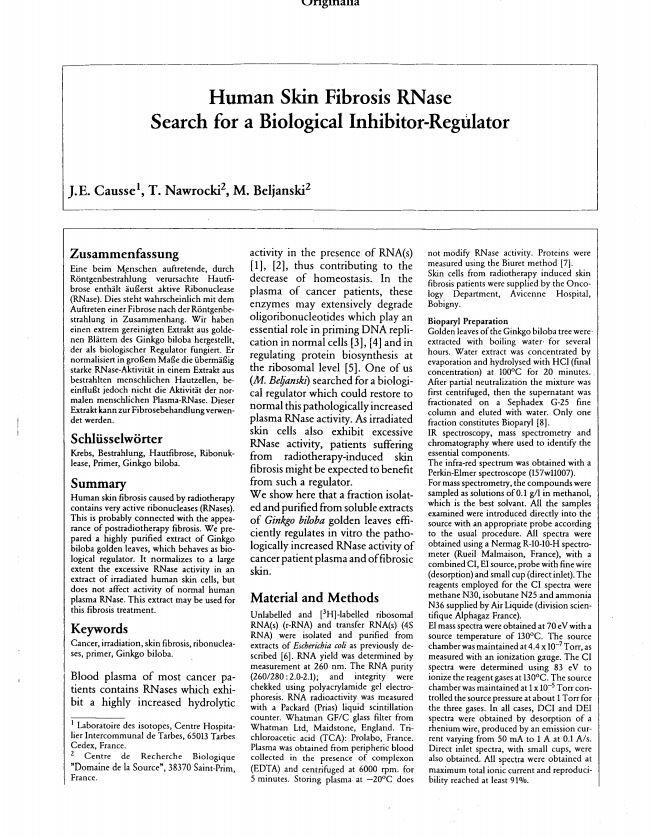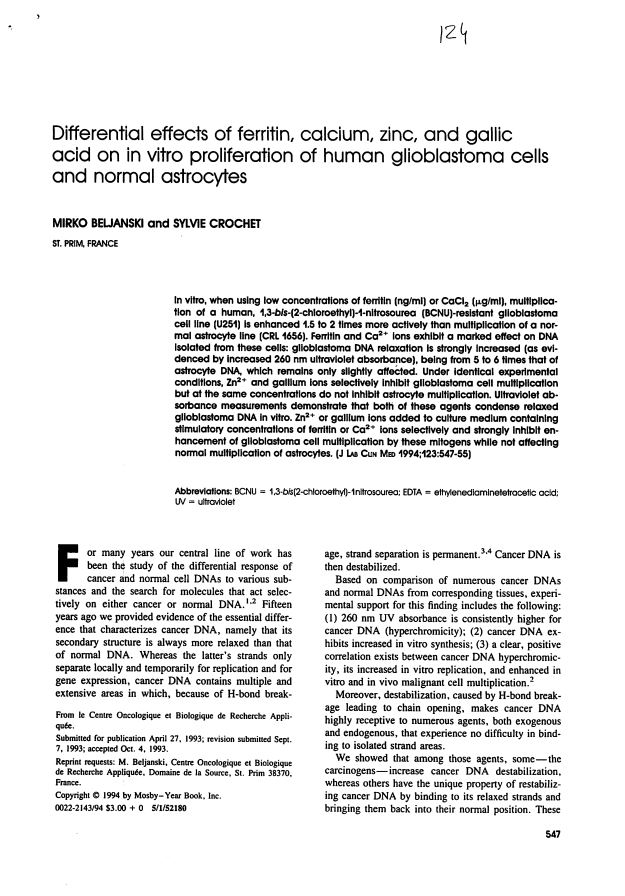133 – The anticancer Agent PB-100, Selectively Active on Malignant Cells, Inhibits Multiplication of 16 Malignant Cell Lines, even Multidrug Resistant
Genetics and Molecular Biology 2000, vol 23 nº1, pp. 29.
Available in English only
ABSTRACT IN ENGLISH: The plant-derived anticancer agent PB-100 (Beljanski® Pao extract) selectively destroys cancer cells, even when multidrug resistant; yet, it does not inhibit normal (non-malignant) cell multiplication. Testing of PB-100 on sixteen cell lines, several multidrug resistant, as well as on five normal cell lines, confirmed our previous results. Flavopereirine and dihydroflavopereirine, the active principles of PB-100, were chemically synthesized and displayed the same selectivity for tumor cells as the purified plant extract, being active at even lower concentrations.
List of cell lines tested : brain (4), ovary (2), breast (2), prostate thyroid (2), colon (2), pancreatic, hepatic, kidney, skin, liver
ABSTRACT IN PORTUGUES : O agente anticancerigeno de origem vegetal PB-100 destroi seletivamente as células cancerosas, mesmo quando elas sao resistentes a multiplas drogas; no entanto, ele nao inibe a multiplicacao de células normais (nao malignas). O teste do PB-100 em 16 linhagens de células malignas, assim como em 5 linhagens de células normais, confirmou nosso resultados prévios. Flavopereirine e dihidroflavopereirine, os principios ativos do PB-100, foram sintetizados quimicamente e mostraram a mesma seletividade para as células tumorais que o extrato purificado da planta, sendo ativos em concentraçoes ainda menores.
ABSTRACT IN ENGLISH: The plant-derived anticancer agent PB-100 (Beljanski® Pao extract) selectively destroys cancer cells, even when multidrug resistant; yet, it does not inhibit normal (non-malignant) cell multiplication. Testing of PB-100 on sixteen cell lines, several multidrug resistant, as well as on five normal cell lines, confirmed our previous results. Flavopereirine and dihydroflavopereirine, the active principles of PB-100, were chemically synthesized and displayed the same selectivity for tumor cells as the purified plant extract, being active at even lower concentrations.
List of cell lines tested : brain (4), ovary (2), breast (2), prostate thyroid (2), colon (2), pancreatic, hepatic, kidney, skin, liver
ABSTRACT IN PORTUGUES : O agente anticancerigeno de origem vegetal PB-100 destroi seletivamente as células cancerosas, mesmo quando elas sao resistentes a multiplas drogas; no entanto, ele nao inibe a multiplicacao de células normais (nao malignas). O teste do PB-100 em 16 linhagens de células malignas, assim como em 5 linhagens de células normais, confirmou nosso resultados prévios. Flavopereirine e dihidroflavopereirine, os principios ativos do PB-100, foram sintetizados quimicamente e mostraram a mesma seletividade para as células tumorais que o extrato purificado da planta, sendo ativos em concentraçoes ainda menores.
132 – De Novo Synthesis of DNA-Like Molecules by Polynucleotide Phosphorylase In Vitro
J. Mol. Evol. 1996, 42:493-499
Available in English only
ABSTRACT: In the presence of Mg2+ ions, polynucleotide phosphorylase (PNPase, EC 2.7.7.8) is known to synthesize RNA-like polymers using ribonucleoside-5′-diphosphate (NDP) substrates but to be unable to utilize deoxyribonucleoside substrates. Our experiments show that when MgCl2 is replaced by FeCl3, PNPase becomes able to synthesize deoxyheteropolymers using deoxyribonucleoside-5′-diphosphates (dNDPs). The deoxyheteropolymer formed from the four dNDPs is degraded by pancreatic DNase, but not by RNase, and is readily used as a template by DNA-dependent DNA polymerase. Synthesis of this DNA-like polymer is accomplished de novo without the help of any primer or preexisting template. What is more, dA/dG and dC/dT ratios of polymers synthesized by different bacterial PNPases closely match ratios found in DNA of the bacterial species the enzyme came from.
ABSTRACT: In the presence of Mg2+ ions, polynucleotide phosphorylase (PNPase, EC 2.7.7.8) is known to synthesize RNA-like polymers using ribonucleoside-5′-diphosphate (NDP) substrates but to be unable to utilize deoxyribonucleoside substrates. Our experiments show that when MgCl2 is replaced by FeCl3, PNPase becomes able to synthesize deoxyheteropolymers using deoxyribonucleoside-5′-diphosphates (dNDPs). The deoxyheteropolymer formed from the four dNDPs is degraded by pancreatic DNase, but not by RNase, and is readily used as a template by DNA-dependent DNA polymerase. Synthesis of this DNA-like polymer is accomplished de novo without the help of any primer or preexisting template. What is more, dA/dG and dC/dT ratios of polymers synthesized by different bacterial PNPases closely match ratios found in DNA of the bacterial species the enzyme came from.
131 – Mitogenic Effect of Several Interleukins, Neuromediators and Hormones on Human Glioblastoma Cells, and its Inhibition by the Selective Anticancer Agent PB-100
Deutsche Zeitschrift für Onkologie, 28, 1, 1996, pp. 14-22
Available in English only
ABSTRACT: We investigated in vitro the effect of six different substances present in the brain on two human cell lines: U251-BCNU-resistant glioblastoma cells, derived from a highly malignant cerebral tumor, and, as their normal counterparts, CRL 1656 astrocytes. The cytokines IL-4 and IL-10 (alone or together with IL-6), the catecholamine neuromediators dopamine and epinephrine, the steroid hormones progesterone and testosterone all significantly stimulated multiplication of the glioblastoma cells, but enhanced to a much lesses extent multiplication of normal astrocytes. The selective anticancer agent PB-100* inhibited these stimulatory effects. In addition, it could dose-dependently kill over 98% of the malignant cells while not affecting normal cells.
ABSTRACT: We investigated in vitro the effect of six different substances present in the brain on two human cell lines: U251-BCNU-resistant glioblastoma cells, derived from a highly malignant cerebral tumor, and, as their normal counterparts, CRL 1656 astrocytes. The cytokines IL-4 and IL-10 (alone or together with IL-6), the catecholamine neuromediators dopamine and epinephrine, the steroid hormones progesterone and testosterone all significantly stimulated multiplication of the glioblastoma cells, but enhanced to a much lesses extent multiplication of normal astrocytes. The selective anticancer agent PB-100* inhibited these stimulatory effects. In addition, it could dose-dependently kill over 98% of the malignant cells while not affecting normal cells.
130 – The selective anticancer agents PB-100 and BG-8 are active against human melanoma cells, but do not affect non malignant fibroblasts
International Journal of Oncology 8:1143-1148, 1996
Available in English only
ABSTRACT: When past the stage amenable to surgery, melanoma and its metastases are, as a rule, treated with chemotherapy, which is largely unsuccessful. In this report, experimental evidence is presented demonstrating that, in vitro, two selective anticancer agents, PB-100 and BG-8, dose dependently destroy human G-361 melanoma cells, but do not affect human non malignant CCD-974Sk fibroblasts used as controls. Trace metal compounds, present, often in abnormal amounts, in the cancer cell and/or its environment, are known to influence its proliferation. Assays were carried out using highly elevated amounts of ferritin, iron chloride or zinc chloride. Ferritin proved differentially mitogenic for melanoma cells and fibroblasts. Its activity was inhibited by both anticancer agents, which however tended to become less efficacious in its presence. FeCl3 was more moderately, but equally, mitogenic for malignant and normal cells, yet it impaired antiproliferative activity of PB-100 and inhibited that of BG-8. ZnCl2 exhibited a selective antiproliferative activity on the malignant melanoma cells; it did not compete with PB-100 or BG-8. Specific recognition and destruction of malignant cells by the two anticancer agents are discussed.
ABSTRACT: When past the stage amenable to surgery, melanoma and its metastases are, as a rule, treated with chemotherapy, which is largely unsuccessful. In this report, experimental evidence is presented demonstrating that, in vitro, two selective anticancer agents, PB-100 and BG-8, dose dependently destroy human G-361 melanoma cells, but do not affect human non malignant CCD-974Sk fibroblasts used as controls. Trace metal compounds, present, often in abnormal amounts, in the cancer cell and/or its environment, are known to influence its proliferation. Assays were carried out using highly elevated amounts of ferritin, iron chloride or zinc chloride. Ferritin proved differentially mitogenic for melanoma cells and fibroblasts. Its activity was inhibited by both anticancer agents, which however tended to become less efficacious in its presence. FeCl3 was more moderately, but equally, mitogenic for malignant and normal cells, yet it impaired antiproliferative activity of PB-100 and inhibited that of BG-8. ZnCl2 exhibited a selective antiproliferative activity on the malignant melanoma cells; it did not compete with PB-100 or BG-8. Specific recognition and destruction of malignant cells by the two anticancer agents are discussed.
129 – Novel selective nontoxic anticancer and antiviral agents
International Journal of Oncology Vol. 7. supplement, p983, October 1995.
Available in English only
ABSTRACT: Selective targeting to diseased cells, ensuring nontoxicity for normal cells, are the master words for anticancer and antiviral therapies. Yet little progress has been made on these lines and adverse side effects are still the rule. After having designed a rapid and simple in vitro screening test (Oncotest), we were able to find a number of plant derived, chemically well defined substances which selectively inhibit cancer cell multiplication without affecting normal cells. Activity of these agents is based on the fact that, as we discovered after extensive comparison of DNAs from cancer cells and their normal counterparts, cancer DNA is characterized by its highly relaxed, destabilized secondary structure, within which H-bond breakage is evidenced by 260 nm UV absorption, always distinctly higher than that of normal DNA. Our anticancer agent easily bind to the “open” cancer DNA chains; in contrast, they do not bind to normal DNA chains, which are “closed” most of the time.
ABSTRACT: Selective targeting to diseased cells, ensuring nontoxicity for normal cells, are the master words for anticancer and antiviral therapies. Yet little progress has been made on these lines and adverse side effects are still the rule. After having designed a rapid and simple in vitro screening test (Oncotest), we were able to find a number of plant derived, chemically well defined substances which selectively inhibit cancer cell multiplication without affecting normal cells. Activity of these agents is based on the fact that, as we discovered after extensive comparison of DNAs from cancer cells and their normal counterparts, cancer DNA is characterized by its highly relaxed, destabilized secondary structure, within which H-bond breakage is evidenced by 260 nm UV absorption, always distinctly higher than that of normal DNA. Our anticancer agent easily bind to the “open” cancer DNA chains; in contrast, they do not bind to normal DNA chains, which are “closed” most of the time.
128 – The anticancer agent PB-100 concentrates in the nucleus and nucleoli of human glioblastoma cells but does not enter normal astrocytes
International Journal of Oncology 7:81-85, 1995.
Available in English only
ABSTRACT: Selectivity of the anticancer agent PB-100 for malignant cells, already demonstrated using cell growth and viability evaluation, is now confirmed by microscopic observations. PB-100 is easily detected inside cells by its yellow color under visible light and by its blue fluorescence; it may be measured in isolated nuclei using its characteristic UV absorbance. After short treatment of human BCNU-resistant glioblastoma cells (U 251) and normal astrocyte controls (CRL 1656), PB-100 accumulates in the malignant cell nucleus, particularly concentrating in the multiple nucleoli and rapidly inducing glioblastoma cell death, whilst, in contrast, the anticancer agent does not even enter normal cells. We had already shown that PB-100 binds to DNA of cancer cells, but not to that of normal cells. In vitro tests described in this report indicate that PB-100 binds to purine bases, but not to pyrimidines, of various ribopolymers and its binding to purine rich nucleic acid stretches is inferred.
ABSTRACT: Selectivity of the anticancer agent PB-100 for malignant cells, already demonstrated using cell growth and viability evaluation, is now confirmed by microscopic observations. PB-100 is easily detected inside cells by its yellow color under visible light and by its blue fluorescence; it may be measured in isolated nuclei using its characteristic UV absorbance. After short treatment of human BCNU-resistant glioblastoma cells (U 251) and normal astrocyte controls (CRL 1656), PB-100 accumulates in the malignant cell nucleus, particularly concentrating in the multiple nucleoli and rapidly inducing glioblastoma cell death, whilst, in contrast, the anticancer agent does not even enter normal cells. We had already shown that PB-100 binds to DNA of cancer cells, but not to that of normal cells. In vitro tests described in this report indicate that PB-100 binds to purine bases, but not to pyrimidines, of various ribopolymers and its binding to purine rich nucleic acid stretches is inferred.
M. Beljanski, Deutsche Zeitschrift für Onkologie, 26, 5, 1994, pp. 137-139.
L’Université de Nanjing a testé l’efficacité du Rauwolfia vomitoria sur des animaux atteints d’HBP et a trouvé les résultats remarquables. Le poids et la taille de la prostate ont été réduits, l’épaisseur de la couche épithéliale de la prostate a diminué et la taille de la lumière a augmenté. L’extrait de Rauwolfia vomitoria a également réduit de manière significative les marqueurs de prolifération induits par la testostérone. Notamment, il n’y a pas eu eu d’effets secondaires négatifs. Le Rauwolfia vomitoria supprime le développement de l’HBP induit par la testostérone et pourrait être un agent thérapeutique prometteur pour l’HBP.
126 – Selective inhibitor (PB-100) of human glioblastoma cell multiplication
International Journal of Oncology, 5:873-879, 1994.
Available in English. French version available on request.
ABSTRACT: The multifunctional cytokine interleukin-6 behaves as a growth factor for various malignancies. It is produced in significant amounts by glioblastoma cells. When exogenous IL-6 is added (pg/ml) to culture medium of human glioblastoma cells and normal (non malignant) astrocytes used as controls, it exerts a dose dependent and differential effect on these two cell lines. Enhancement of cell proliferation is twice as high for glioblastoma cells as for astrocytes. In vitro, the novel anticancer agent PB-100 (mu g/ml) dose dependently inhibits this stimulatory activity. In addition, increasing PB-100 concentrations finally induce death of the malignant cells, yet do not impede multiplication of normal astrocytes. PB-100 does not abolish IL-6 production by cells, but keeps its level down to physiological values. PB-100 should therefore find its place in therapies requiring control of IL-6 production.
ABSTRACT: The multifunctional cytokine interleukin-6 behaves as a growth factor for various malignancies. It is produced in significant amounts by glioblastoma cells. When exogenous IL-6 is added (pg/ml) to culture medium of human glioblastoma cells and normal (non malignant) astrocytes used as controls, it exerts a dose dependent and differential effect on these two cell lines. Enhancement of cell proliferation is twice as high for glioblastoma cells as for astrocytes. In vitro, the novel anticancer agent PB-100 (mu g/ml) dose dependently inhibits this stimulatory activity. In addition, increasing PB-100 concentrations finally induce death of the malignant cells, yet do not impede multiplication of normal astrocytes. PB-100 does not abolish IL-6 production by cells, but keeps its level down to physiological values. PB-100 should therefore find its place in therapies requiring control of IL-6 production.
125 – The selective anticancer agent PB-100 inhibits interleukin-6 induced enhancement of glioblastoma cell in vitro
International Journal of Oncology, 5:873-879, 1994.
Available online in English. French version upon request.
ABSTRACT: The multifunctional cytokine interleukin-6 behaves as a growth factor for various malignancies. It is produced in significant amounts by glioblastoma cells. When exogenous IL-6 is added (pg/ml) to culture medium of human glioblastoma cells and normal (non malignant) astrocytes used as controls, it exerts a dose dependent and differential effect on these two cell lines. Enhancement of cell proliferation is twice as high for glioblastoma cells as for astrocytes. In vitro, the novel anticancer agent PB-100 (mu g/ml) dose dependently inhibits this stimulatory activity. In addition, increasing PB-100 concentrations finally induce death of the malignant cells, yet do not impede multiplication of normal astrocytes. PB-100 does not abolish IL-6 production by cells, but keeps its level down to physiological values. PB-100 should therefore find its place in therapies requiring control of IL-6 production.
ABSTRACT: The multifunctional cytokine interleukin-6 behaves as a growth factor for various malignancies. It is produced in significant amounts by glioblastoma cells. When exogenous IL-6 is added (pg/ml) to culture medium of human glioblastoma cells and normal (non malignant) astrocytes used as controls, it exerts a dose dependent and differential effect on these two cell lines. Enhancement of cell proliferation is twice as high for glioblastoma cells as for astrocytes. In vitro, the novel anticancer agent PB-100 (mu g/ml) dose dependently inhibits this stimulatory activity. In addition, increasing PB-100 concentrations finally induce death of the malignant cells, yet do not impede multiplication of normal astrocytes. PB-100 does not abolish IL-6 production by cells, but keeps its level down to physiological values. PB-100 should therefore find its place in therapies requiring control of IL-6 production.
124 – Differential effects of ferritin, calcium, zinc and gallic acid on in vitro proliferation of human glioblastoma cells and normal astrocytes
J. Lab. Clin. Med. 123:547-555, 1994.
Available in English only
ABSTRACT: In vitro, when using low concentrations of ferritin (ng/ml) or CaCl2 (micrograms/ml), multiplication of a human, 1,3-bis-(2-chloroethyl)-1-nitrosourea (BCNU)-resistant glioblastoma cell line (U251) is enhanced 1.5 to 2 times more actively than multiplication of a normal astrocyte line (CRL 1656). Ferritin and Ca2+ ions exhibit a marked effect on DNA isolated from these cells: glioblastoma DNA relaxation is strongly increased (as evidenced by increased 260 nm ultraviolet absorbance), being from 5 to 6 times that of astrocyte DNA, which remains only slightly affected. Under identical experimental conditions, Zn2+ and gallium ions selectively inhibit glioblastoma cell multiplication but at the same concentrations do not inhibit astrocyte multiplication. Ultraviolet absorbance measurements demonstrate that both of these agents condense relaxed glioblastoma DNA in vitro. Zn2+ or gallium ions added to culture medium containing stimulatory concentrations of ferritin or Ca2+ ions selectively and strongly inhibit enhancement of glioblastoma cell multiplication by these mitogens while not affecting normal multiplication of astrocytes.
ABSTRACT: In vitro, when using low concentrations of ferritin (ng/ml) or CaCl2 (micrograms/ml), multiplication of a human, 1,3-bis-(2-chloroethyl)-1-nitrosourea (BCNU)-resistant glioblastoma cell line (U251) is enhanced 1.5 to 2 times more actively than multiplication of a normal astrocyte line (CRL 1656). Ferritin and Ca2+ ions exhibit a marked effect on DNA isolated from these cells: glioblastoma DNA relaxation is strongly increased (as evidenced by increased 260 nm ultraviolet absorbance), being from 5 to 6 times that of astrocyte DNA, which remains only slightly affected. Under identical experimental conditions, Zn2+ and gallium ions selectively inhibit glioblastoma cell multiplication but at the same concentrations do not inhibit astrocyte multiplication. Ultraviolet absorbance measurements demonstrate that both of these agents condense relaxed glioblastoma DNA in vitro. Zn2+ or gallium ions added to culture medium containing stimulatory concentrations of ferritin or Ca2+ ions selectively and strongly inhibit enhancement of glioblastoma cell multiplication by these mitogens while not affecting normal multiplication of astrocytes.






